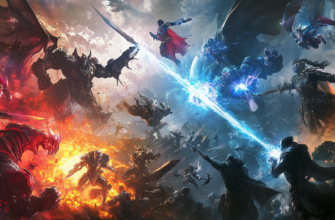- Understanding games as a service: What it brings to the table for developers
- What is games as a service?
- How do developers benefit from games as a service?
- 1. Long-term monetization
- 2. Extended lifecycle of a game
- 3. Fostering a community
- Some practical tips and advice for developers using GaaS
- 1. Microtransactions: Do it right!
- 2. Regular content updates are essential
- 3. Engaging events and seasonal tiers
- 4. Transparency with the community matters
- The conclusion: Why games as a service isn’t going anywhere
Understanding games as a service: What it brings to the table for developers
Hey there, fellow gamer! Ever wonder why some of your favorite games seem to have endless updates, expansions, and new content even years after their launch? Well, it’s all part of a model called “games as a service” (GaaS), and it’s a term that’s been popping up more and more in the gaming community over the last few years. Whether you’re into multiplayer shooters like Destiny 2, MMOs like World of Warcraft, or even single-player experiences with ongoing DLCs, chances are you’ve already encountered this business model. But, here’s the thing—while many gamers shake their fists at it, GaaS can be incredibly beneficial for game developers.
Let’s dive into what “games as a service” really means and why developers are leaning into this model. Buckle up—this might just change how you view your favorite games going forward.
What is games as a service?
Okay, so let’s break it down. “Games as a service” might sound complicated, but it’s really not—think of it like a Netflix subscription for your game library. Instead of games being a one-and-done deal where developers work hard to release a polished product and move on to the next, GaaS emphasizes constant development and live support. In this model, developers continue to create content, updates, and events for a game long after its initial release.
- These updates could include new characters, weapons, seasons, or storylines.
- They often come with cosmetics or performance improvements as well.
- It also involves regular patches and fixes to balance the game and keep things fresh.
Now, instead of just sticking that freshly-bought disc into your console or downloading a static final product from your PC store, you’re playing in an ever-evolving world that’s constantly tweaking and refreshing itself.
Some of the most successful games that use the GaaS model are:
- Fortnite – With its seasonal events and weekly challenges, Epic Games keeps players engaged long after initial release.
- Grand Theft Auto V Online – Rockstar still drives immense player count years after launch with its intriguing online multiplayer experience.
- Destiny 2 – Bungie continues to release major expansions, keeping players hooked with new content.
How do developers benefit from games as a service?
So, now that you’ve got the concept down—let’s look at why developers absolutely love GaaS. Spoiler: it’s all about sustainability, better customer relationships, and of course, monetization. If you thought the goal was to just make that big $60 sale and call it quits, think again.
1. Long-term monetization
Here’s the thing—developers are businesses, and they need money to stay afloat. After the initial release of a game, its revenue can plummet because, let’s face it, nobody’s buying copies of a 5-year-old game. But, when developers create an experience that lives and breathes beyond its launch through updates, expansions, and additional content, they also secure multiple revenue streams.
This could include:
- In-game purchases: Skins, special items, emotes, or even weapons that generate income through microtransactions while giving your character or account a personalized touch.
- Battle passes or subscriptions: Games often release seasonal or monthly passes, which not only give you challenges but also rewards like skins or loot. Think of the popularity of the Fortnite Battle Pass and how it drives constant engagement.
- Expansions or DLC: Developers can release new areas, quests, or even entire game modes as paid DLC packages or expansions. This keeps the fanbase craving more while providing developers with cash flow beyond the initial release.
2. Extended lifecycle of a game
Let me give you an example. When The Elder Scrolls V: Skyrim came out in 2011, it was one of the most critically acclaimed games. But it was a finite single-player experience. Fast forward to games like World of Warcraft, which used the GaaS model and continues to thrive after almost two decades. It’s not just because of nostalgia—it’s because the game is constantly updated, expanded, and brought into the future with fresh content.
When developers adopt a GaaS model, they’re ensuring that their game’s lifecycle doesn’t end within a few months. Instead, they can keep players returning with new content, events, and even unforeseen expansions. More players mean more revenue and a longer period to recoup development costs and even profit hugely from what they create. Plus, players are less likely to abandon the game in favor of newer releases if they’re always getting fresh incentives to stick around.
3. Fostering a community
Another massive plus for developers using the GaaS model? Communities. Yes, that toxic one in your favorite online gaming forum that loves to rage about updates—surprisingly, it can be powerful.
When a game is continuously supported, it develops an active, engaged community. Whether through official forums, social media pages, or subreddits, players begin to bond over their shared experiences. Now, as a developer, this is amazing because they don’t just create a customer base—they create fans who are legit invested in the future of your game. And when someone’s invested, they’re more likely to engage financially (in-game purchases) or emotionally (spreading the word, making fan art, streaming your game).
A passionate community can even end up doing major PR work for the developer as their excitement spreads like wildfire through social networks and YouTube hype reviews. Epic Games mastered this with Fortnite when various live events drew in massive views and participation on Twitch.
Some practical tips and advice for developers using GaaS
Now, switching to GaaS is no magic wand—it takes planning and effort. I’ll share some practical advice for developers who might be new to this model or trying to enhance their existing service-based game.
1. Microtransactions: Do it right!
I know, I know — microtransactions get a bad rep among gamers (looking at you Star Wars Battlefront II), but when done with respect, they can significantly help developers generate income without hurting the player experience. Keep your microtransactions focused on cosmetic items that don’t affect game balance. That way, you’re securing money without alienating the player base or making the game feel like a pay-to-win experience.
2. Regular content updates are essential
Players get bored quickly. If you’re not continually releasing new storylines, weapons, skins, or events, you’ll end up with server ghosts. Keeping the content fresh and frequent is what’ll keep your fan base motivated—and stick to a schedule if possible.
3. Engaging events and seasonal tiers
Apex Legends and Fortnite are great examples of how to throw in seasonal events, time-limited challenges, and unique rewards associated with each new level. These events make the game feel dynamic and engaging, giving players reasons to return during those specific windows of time. The feeling of exclusivity (limited-time items or events) is a massive motivator. Make your players feel like they’ll miss out on something incredible if they don’t log in!
4. Transparency with the community matters
This is a big one—players have a love/hate relationship with developers. When new patches or controversial expansion packs drop, gamers inevitably have questions or criticisms. Being open and transparent, explaining why certain changes are being made, or actively responding to feedback will help maintain a healthy relationship. Responding to community concerns on forums or social media can go a long way in keeping players around.
The conclusion: Why games as a service isn’t going anywhere
For developers, games as a service isn’t just a trendy business model—it’s an essential path for both sustainability and staying competitive in an ever-evolving marketplace. This model allows creators to keep player engagement high, expand the longevity of their titles, foster a loyal community, and create steady financial income streams through strategic monetization.
Sure, some players may gripe about the constant in-game purchases and updates, but, done right, GaaS can make the gaming experience richer and more communal. Developers get to keep doing what they love—creating games, while players enjoy a dynamic, evolving experience that isn’t limited by the boundaries of a static title played for a few hours and tossed aside.
Are you a fan of games as a service, or do you prefer the traditional one-time-purchase experience? Hit me up in the comments, and let’s get some good gaming chat going!


















Highly descriptive article, I liked that bit. Will there be a part
2?
My web blog; Check it out
Pro tip: Sprunk community samples are royalty-free gold!
Thank you for sharing your thoughts. I truly appreciate your efforts and I am waiting for your further post thank you once again.
my blog nordvpn coupons inspiresensation
Some times its a pain in the ass to read what people wrote but this website is really user pleasant! .
Understanding the psychology of gambling is crucial-especially with platforms like SuperPH, which blend entertainment with real stakes. Their bonuses and tournaments can trigger reward-seeking behavior, making mindful play essential.
01msyt
Online gambling needs secure platforms, and JiliOK delivers with its AI-driven gameplay and smooth registration process. A trustworthy choice for Filipino players. Check it out at Jili OK.
Interesting points about skill development through online games! It’s great to see platforms like kkwim login focusing on a safe & progressive gaming experience – crucial for building confidence & strategy. Definitely a growing trend!